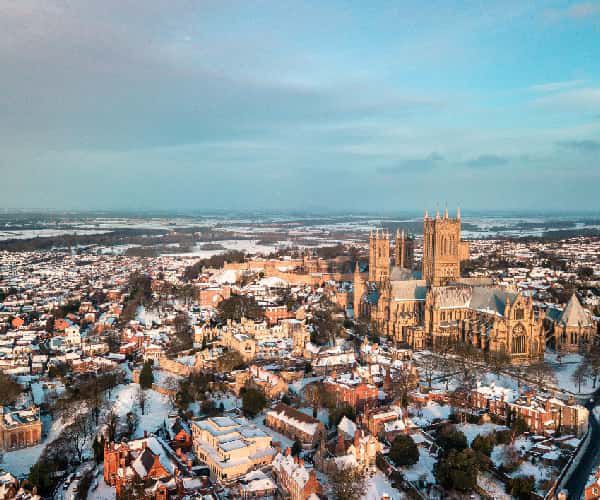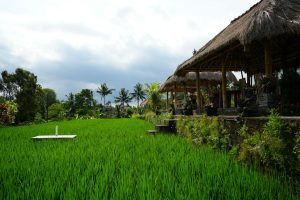
The rich, lush, varied countryside of Lincolnshire is often overlooked when we think about holidays in England, but this ancient and diverse landscape is making a comeback with those who love the quiet and serenity of the outdoors and discovering magnificent English countryside like no other.
Sitting above the royal county of Norfolk, Lincolnshire is an undisturbed corner of the East Midlands brimming with wildlife, history, and culture. Glampers looking for a new area of the UK to stay and explore will be delighted with the wide-ranging activities and breathtaking scenery of this oft-forgotten county, and perhaps it is the fact that it is mostly been undisturbed by tourism that makes this county so special. It’s a landscape that feels timeless, teeming with flourishing species of animals and plants, bordered with a beautiful sandy coastline to the East and dotted with the best examples of British heritage throughout.

1. The Lincolnshire Wolds
In a landscape well-known for being flat, the Lincolnshire Wolds are a range of hills that run like the county’s curvaceous spine from the Humber Estuary right to the edge of the Fens. This fantastic 216 square mile territory is an Area of Outstanding Natural Beauty, and unlike some untouched, wild AONBs, this landscape is a patchwork of farmed landscapes and small settlements, long barrows, and medieval ruins. Nature enthusiasts will love the open, rural landscapes, filled with red deer and rare flowers, its mixed woodland admired and immortalised by poets such as Tennyson. The Wolds’ cycle paths, walking routes, and bridle paths run like veins across the best-kept secret of Lincolnshire, allowing visitors and locals alike to discover this distinctive landscape in whichever form they choose.

2. Skegness and its less-known, must-see stretches of coastline
The award-winning beach and traditional seaside town of Skegness sit resplendent on the border between land and the North Sea. This is one of the most well-known spots in the county, with visitors arriving with the completion of the first-ever Butlins in 1936. Now, Skegness is a wonderful example of the classic English seaside resort, with its esplanade receiving a makeover to make it a more upmarket town. For those who prefer their coastline a little more wild and windswept, then Gibraltar Point National Nature Reserve is just to the south of Skegness, and the intertidal habitats that surround the shore make it a Site of Special Scientific Interest. Donna Nook National Nature Reserve to the North of the county boasts more than 10km of sleek sandy beaches which are home to a large colony of grey seals – special viewing areas have been set up to view the pups without disturbing the seals and their feeding times.

3. Go glamping in one of the six amazing treehouses
No matter what season, if you’re looking for tranquility and a time for reflection you’ll find just what you need in one of the most unique accommodation experiences in the region; and in one of 6 of these uniquely appointed, luxury treetop boltholes. Your cosy home in the trees offers the ultimate return to nature in one of these eco-chic structures built around private, secluded lakes on the edge of Lincolnshire’s most attractive village, in Woodhall Spa. The chic interiors combine rustic with contemporary providing you with a calm, comfortable self-catering experience. The colour schemes are in warm natural tones, from shades of cream, through to browns, greens, and greys with flashes of contrasting colour here and there.
Big picture windows in the lounge let the warm light flood in and the views over the lake are truly breathtaking. Relax in your own private steaming hot outdoor bathtub, enjoying the subtle sounds of the birds, the bees, and the rustle in the trees. Rustic wooden walls and spacious open plan living, ambient lighting, and a roaring wood-burning stove are just the place to relax after a day exploring or rowing on the lake. Famous for its peaceful and relaxing atmosphere, the unique site at Woodhall Spa, is set on the outskirts of this beautiful, little village, which is close to the Lincolnshire Wolds, and steeped in history. Offering many fine restaurants, cafes’ and individual boutique shops, it makes it the perfect location for a short break or glamping experience with a ‘forward to nature’ appeal.

4. Visit the windmill capital of the UK
Lincolnshire’s flat landscape and breezy North Sea border made it the ideal spot for harnessing the power of the wind; it is thought that the county once boasted over 500 windmills. Now, just the ruins of 136 windmills remain. Maud Foster Windmill, however, is preserved, and though a private residence now, can be found in the town of Boston and is over 300 years old. In 1988 it was restored to its former working glory and opened to visitors. It has 7 floors with spectacular views over the town and countryside from the top. Other notable mills to visit in the area are Cogglesford Watermill which sits on the stunning riverbank in Sleaford, where you can purchase the organic wholemeal flour that the mill produces or the eight-sailed Victorian windmill at Heckington and its microbrewery providing award-winning beer.

5. The historic cathedral city and the county town of Lincoln
No trip to Lincolnshire would be complete without a day trip out of the ancient wooded countryside and into the glorious English Gothic streets of Lincoln. This city has been inhabited since the first century BC, with evidence of Iron Age, Roman, Viking, and Norman occupation. The city’s main iconic building is Lincoln Cathedral, rebuilt after the misfortune of a fire followed by an earthquake in 1185 and now a magnificently recognizable feature on Lincoln’s skyscape. Its grandeur and seminalism are seconded only by Lincoln castle, built in 1085 by William the Conqueror. Its presence has reassuringly protected this ancient city for over one thousand years and is home to one of only four remaining original copies of the Magna Carta.
Beyond the official buildings’ precincts, Lincoln’s streets are packed full of a plethora of its history; from half-timbered housing leaning precariously over the river to the 3rd century Newport Arch, a Roman gate, from the tank museum to the medieval Bishop’s palace, Lincoln has something fascinating to offer at every turn.

6. Heritage trails and great houses
If you’ve chosen to be in the great outdoors, then Lincolnshire has a wealth of trails and gardens, cycling routes, and grounds for you to explore. Doddington Hall is on the edge of Lincoln and is a popular spot for accessing routes such as the George Twigg track, a smooth, winding cycle track through the bucolic countryside. From the lavish Burghley House you are invited to traverse the huge expanse of parklands that surround this heritage site or take the many heritage trails that lead through Lincoln city itself, such as the historic Roman trail or the popular aviation trail.

7. Finding the Fens
The Lincolnshire Fens are some of the most outstanding wetlands in the UK. This massive expanse of marshland stretched over 1,500 square miles in Lincolnshire and out to nearby Cambridgeshire and Norfolk. The Fenland would originally have been salt-water wetlands, but much of the county’s fens have been drained and now make fantastically fertile arable land – in fact, they contain about half of the grade 1 agricultural land in England. In South Lincolnshire, a project has begun to restore part of the wetland back to its glacial beginnings, uncovering ancient underlying forests in the peat fens and encouraging flora, fauna, and animals to occupy the original habitat. You can still find stunning marshland in the south of the county around Thurbly, Baston and Deeping Fens, with wildfowl and wading birds peeping from the reed beds. This is an area like no other in the UK and walking and driving guides allow you to take in the 4 nature reserves situated within the existing Fens.

Lincolnshire really does have something for every guest – from wetlands to beaches, great houses to windmills, castles, and cathedrals to military museums. Lincolnshire is a delight for all who visit this idyllic, historic landscape.
Tim Rees is Founder and CEO at Quality Unearthed. Quality Unearthed is a world-leading glamping and alternative accommodation agency providing ‘forward to nature’ holidays, established in 2010.
If you would like to be a guest blogger on A Luxury Travel Blog in order to raise your profile, please contact us.





